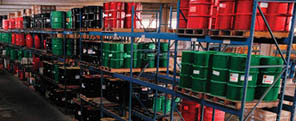Think Twice Before Changing a Proven Brand of Lubricant
Almost any machinist with experience on the job may have been asked to transition from one lube product to another for an operation, a machine or a specific application. No problem, right? After all, there are many manufacturers that make competitive machining fluids that fit your application and lube delivery system.
What could go wrong? The answer is -- plenty!
Don't Change for Change's Sake
Change is not necessarily a bad thing, but make sure there is a reason for a lube brand change. It may be driven by economics, the prospect of improved machine performance or tool life, the need to consolidate lube inventory, operator issues, environmental factors - or the discontinuation of your current lube product. One industry survey cites that more than half of industry lube professionals regard poor performance as the biggest reason for a lube change.
The fact is, lube brand changes may well improve the cost and performance of your operations. However, changing lubes is not something to be done without serious regard for its effect on equipment, personnel and bottom line.
As a practical matter, any considered changes in machine lubricants should be accompanied by a lube audit.
This is not the place to throw caution to the wind.
Evaluate the Risks
At the core of this cautionary approach is that risks lurk around the process and equipment involved with lube brand changes. Minimizing these risks is crucial to the success of the possible change and the subsequent performance of the machinery.
Risk may take many forms in lube brand changeovers. For example, inadvertent or unavoidable mixing of the new lube with the old may lead to a chemical breakdown and inferior lube performance. A new lube may react adversely to machine surfaces that are painted, caulked or otherwise sealed or coated; its sensitivity to various plant and atmospheric conditions may also vary significantly from the previous product. A new lube formulation may be incompatible with other products and raw material residues present in the machinery.
Lube Comparability and Compatibility
Don't make the mistake of assuming that these are the same thing -- they aren't.
Comparable products have similar physical properties and may be used in your existing machinery, but care must be taken to ensure that they are not mixed with the old lube, since they may not be compatible with each other.
A new lube compatible with the old one implies a similar chemical composition, and machine performance may not be adversely affected if the old and new lubricants mix in trace amounts. However, in such a situation the lube analysis lab should make careful and frequent evaluations of lube composition to look for potentially harmful changes.
Testing for Compatibility
There are a number of methods and tests used to determine lube compatibility. One of these is ASTM D7155, which involves preparing mixtures of two lubricants of questionable compatibility in varying proportions. In this method's Tier 1 test, these are heated to allow the base oils and additives to interact. If the observed mixture is then seen to have developed a discoloration, sedimentation or change in opacity (cloudiness), the lubricants are likely not to be compatible. If none of these changes occur, depending on the criticality of the machine and the operation, Tier 2 tests defined in the method are suggested to screen for compatibility at a higher confidence level.
NEXT ESSAY

|



